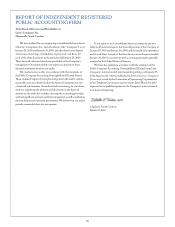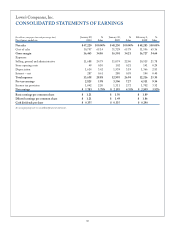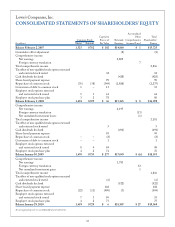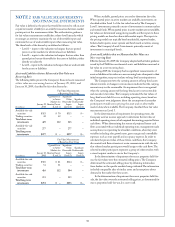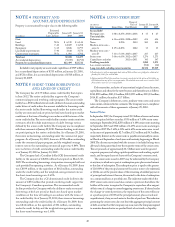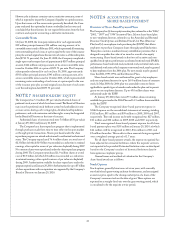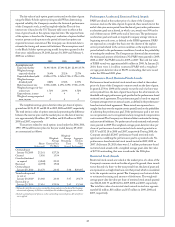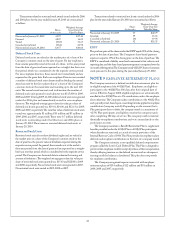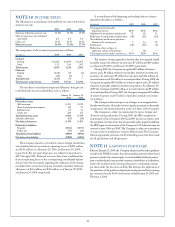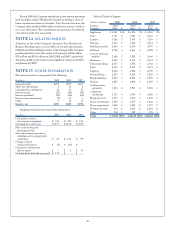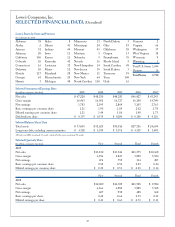Lowe's 2009 Annual Report Download - page 39
Download and view the complete annual report
Please find page 39 of the 2009 Lowe's annual report below. You can navigate through the pages in the report by either clicking on the pages listed below, or by using the keyword search tool below to find specific information within the annual report.
37
Cost of Sales and Selling, General and Administrative Expenses –
e following lists the primary costs classified in each major expense
category:
Cost of Sales
• Total cost of products sold, including:
- Purchase costs, net of vendor funds;
- Freight expenses associated with moving merchandise
inventories from vendors to retail stores;
- Costs associated with operating the Company’s distribution
network, including payroll and benefit costs and occupancy costs;
• Costs of installation services provided;
• Costs associated with delivery of products directly from vendors
to customers by third parties;
• Costs associated with inventory shrinkage and obsolescence.
Selling, General and Administrative
• Payroll and benefit costs for retail and corporate employees;
• Occupancy costs of retail and corporate facilities;
• Advertising;
• Costs associated with delivery of products from stores
to customers;
• ird-party, in-store service costs;
• Tender costs, including bank charges, costs associated with
credit card interchange fees and amounts associated with
accepting the Company’s proprietary credit cards;
• Costs associated with self-insured plans, and premium costs
for stop-loss coverage and fully insured plans;
• Long-lived asset impairment losses and gains/losses on
disposal of assets;
• Other administrative costs, such as supplies, and travel
and entertainment.
Advertising – Costs associated with advertising are charged to
expense as incurred. Advertising expenses were $750 million, $789
million and $788 million in 2009, 2008 and 2007, respectively.
Shipping and Handling Costs – e Company includes shipping
and handling costs relating to the delivery of products directly from
vendors to customers by third parties in cost of sales. Shipping and
handling costs, which include third-party delivery costs, salaries and
vehicle operations expenses relating to the delivery of products from
stores to customers, are classified as SG&A expense. Shipping and
handling costs included in SG&A expense were $371 million,
$378 million and $361 million in 2009, 2008 and 2007, respectively.
Store Opening Costs – Costs of opening new or relocated retail
stores, which include payroll and supply costs incurred prior to store
opening and grand opening advertising costs, are charged to expense
as incurred.
Comprehensive Income – e Company reports comprehensive
income on its consolidated statements of shareholders’ equity.
Comprehensive income represents changes in shareholders’ equity
from non-owner sources and is comprised primarily of net earnings
plus or minus unrealized gains or losses on available-for-sale securities,
as well as foreign currency translation adjustments. Unrealized gains,
net of tax, on available-for-sale securities classified in accumulated
other comprehensive income (loss) on the consolidated balance sheets
were $2 million at both of January 29, 2010 and January 30, 2009.
Foreign currency translation gains, net of tax, classified in accumulated
other comprehensive income (loss) were $25 million at January 29, 2010.
Foreign currency translation losses, net of tax, classified in accumulated
other comprehensive income (loss) were $8 million at January 30, 2009.
e reclassification adjustments for gains/losses included in net
earnings were not significant for any of the periods presented.
Recent Accounting Pronouncements – In June 2009, the Financial
Accounting Standards Board (FASB) issued authoritative guidance
which amends the derecognition guidance on accounting for transfers
of financial assets. e guidance is effective for financial asset transfers
occurring in fiscal years beginning after November 15, 2009, and interim
periods within those fiscal years. e adoption of the guidance will not have
a material impact on the Company’s consolidated financial statements.
In June 2009, the FASB issued authoritative guidance which
amends the consolidation guidance for variable interest entities. e
guidance is effective for fiscal years beginning after November 15,
2009, and interim periods within those fiscal years. e adoption
of the guidance will not have a material impact on the Company’s
consolidated financial statements.
In October 2009, the FASB issued authoritative guidance on
multiple-deliverable revenue arrangements, which addresses the unit
of accounting for arrangements involving multiple deliverables. e
guidance also addresses how arrangement consideration should be
allocated to separate units of accounting, when applicable, and expands
the disclosure requirements for multiple-deliverable arrangements.
e guidance is effective for fiscal years beginning after June 15, 2010.
e Company does not expect the adoption of the guidance to have a
material impact on its consolidated financial statements.
In January 2010, the FASB issued authoritative guidance related
to fair value measurements which requires additional disclosures about
transfers into and out of Levels 1 and 2, and separate disclosures
about purchases, sales, issuances and settlements relating to Level 3
measurements. e guidance also clarifies existing fair value disclosures
about the level of disaggregation and about inputs and valuation
techniques used to measure fair value. e guidance is effective for
the first reporting period, to include interim periods, beginning after
December 15, 2009, except for the portion of the guidance relating
to Level 3 activity, which is effective for fiscal years beginning after
December 15, 2010, and for interim periods within those fiscal years.
e Company does not expect the adoption of the guidance to have
a material impact on its consolidated financial statements.
Segment Information – e Company’s home improvement retail
stores represent a single operating segment based on the way the
Company manages its business. Operating decisions are made at the
Company level in order to maintain a consistent retail store presentation.
e Company’s home improvement retail stores sell similar products
and services, use similar processes to sell those products and services,
and sell their products and services to similar classes of customers.
e amounts of long-lived assets and net sales outside the U.S. were
not significant for any of the periods presented.
Reclassifications – Certain prior period amounts have been
reclassified to conform to current classifications. e long-term portion
of the self-insurance liabilities, primarily for workers’ compensation,
automobile, property, and general and product liability claims, of
$462 million at January 30, 2009, previously classified as current on
the consolidated balance sheets, has been reclassified to other liabilities
(non-current). e current portion of these self-insurance liabilities,
previously reported as a single line item on the consolidated balance sheets,
has been combined with other current liabilities. e non-current
portion of deferred income taxes related to these self-insurance liabilities
has also been reclassified from current to non-current deferred income
taxes in the consolidated balance sheets. ese changes were not
material and had no impact on the consolidated statements of earnings,
shareholders’ equity or cash flows for any of the periods presented.



